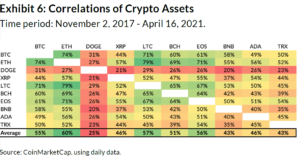The Future of Cryptocurrencies: Trends to Enjoy in the Upcoming Years
As we look in advance, the landscape of cryptocurrencies is going through profound modifications influenced by a number of crucial fads. The emergence of Central Financial institution Digital Currencies (CBDCs) stands to redefine the combination of digital possessions within standard monetary systems, while enhanced governing examination may form the operational landscape for cryptocurrencies. Additionally, the advancement of decentralized money (DeFi) and the growing value of non-fungible tokens (NFTs) assure to change assumptions of ownership and assessment in an electronic economic situation. These developments increase essential concerns regarding the future trajectory of cryptocurrencies and their role in our monetary ecosystem.
Rise of Central Financial Institution Digital Currencies
The emergence of Central Bank Digital Currencies (CBDCs) represents a significant shift in the monetary landscape as federal governments check out electronic choices to standard fiat money. These state-backed digital money intend to improve the effectiveness of settlement systems, promote monetary inclusion, and give a secure option to exclusive cryptocurrencies. Unlike decentralized digital currencies, CBDCs operate under the auspices of reserve banks, guaranteeing regulatory oversight and stability.
A number of countries are proactively piloting or researching CBDCs, with notable instances consisting of China's digital yuan and the European Reserve bank's electronic euro campaign. These efforts highlight a growing acknowledgment of the possible advantages of electronic currencies, such as faster deal speeds and reduced costs linked with cross-border repayments. In addition, CBDCs can work as a device to deal with illicit tasks by providing higher openness in purchases.
As the fostering of CBDCs progresses, they may improve customer behavior and influence worldwide monetary characteristics. Nonetheless, the transition to an electronic money structure presents challenges, including technological framework, cybersecurity worries, and public trust fund. The surge of CBDCs indicates a zero hour that might redefine the function of money in an increasingly electronic economic situation, calling for close observation by industry stakeholders and policymakers alike.
Raised Governing Examination

Countries globally are taking different strategies, from straight-out restrictions to regulative sandboxes that allow advancement while guaranteeing conformity. The European Union, for example, is relocating towards extensive legislation with the marketplaces in copyright-Assets Guideline (MiCA), focused on developing a unified approach throughout member states. In the USA, firms like the SEC and CFTC are significantly energetic in releasing standards and enforcement activities.
Companies operating in the copyright space may deal with more stringent conformity demands, which might lead to raised operational expenses. Eventually, the equilibrium in between technology and regulation will certainly shape the future of cryptocurrencies.
Evolution of DeFi Platforms
Decentralized Money (DeFi) systems have actually undertaken significant transformation because their inception, reshaping the traditional financial landscape - order cryptocurrencies. Initially, these platforms primarily concentrated on straightforward features such as loaning and loaning, helped with by wise contracts on blockchain networks. However, the evolution of DeFi has actually broadened to include a wide selection of economic services, including by-products trading, yield farming, and automated market-making.
One of one of the most noteworthy developments is the emergence of Layer 2 remedies, which improve scalability and reduce purchase go to website expenses, making DeFi more obtainable to a wider audience. Furthermore, cross-chain interoperability has come to be a vital focus, enabling users to move assets effortlessly across different blockchain networks. This advancement promotes better liquidity and individual involvement.
Furthermore, the assimilation of sophisticated administration models has encouraged communities to take part in decision-making processes, promoting sustainability and technology within the environment. As DeFi proceeds to mature, we can anticipate more enhancements in individual experience via improved user interfaces and security steps, dealing with worries that have actually previously impeded mainstream fostering. On the whole, the trajectory of DeFi platforms points toward a much more comprehensive and efficient financial future, using choices to standard banking systems.
Integration of NFTs in Financing
Among the rapid evolution of the monetary landscape, the assimilation of Non-Fungible Symbols (NFTs) has emerged as a transformative pressure. Generally connected with electronic art and antiques, NFTs are currently finding applications in different financial industries, introducing innovative methods to represent ownership and worth.
One significant area of integration is in property, where NFTs can simplify residential property deals. By tokenizing property properties, purchasers can take pleasure in fractional possession, minimizing entrance barriers and enhancing liquidity. order cryptocurrencies. Furthermore, NFTs can guarantee transparent and immutable i loved this documents of possession, improving rely on genuine estate transactions
On the planet of finance, NFTs are also being made use of for decentralized money (DeFi) applications, allowing collateralization of possessions. By utilizing NFTs as collateral, consumers can access loans while preserving possession of their digital assets. This capability improves the availability of monetary solutions and advertises a more comprehensive economic environment.
Furthermore, the integration of NFTs right into conventional finance can transform the way intellectual property civil liberties are managed, giving designers with brand-new profits streams through clever contracts. Overall, the combination of NFTs in finance indicates a shift in the direction of more cutting-edge, effective, and clear monetary solutions, leading the way for future developments.
Developments in Blockchain Innovation

One substantial trend is the introduction of Layer 2 solutions, made to enhance scalability and transaction speeds, therefore dealing with the constraints of main blockchain networks. These options enable quicker processing of purchases, minimizing charges and raising efficiency, which is vital for mass adoption.
Moreover, interoperability between different blockchain networks is acquiring traction. This development allows seamless data exchange and asset transfers throughout varied systems, advertising a much more connected and efficient community. Protocols that facilitate cross-chain interaction are essential for cultivating cooperation amongst decentralized applications (copyright) and boosting customer experiences.
Furthermore, improvements in consensus mechanisms, such as proof-of-stake and delegated proof-of-stake, are adding useful link to even more energy-efficient and protected blockchain operations. These innovations not just attend to environmental concerns yet likewise improve network resilience.
As blockchain modern technology remains to mature, its assimilation right into various fields, consisting of finance, supply chain, and medical care, will certainly redefine conventional systems, leading the way for a decentralized future.
Conclusion
In verdict, the future of cryptocurrencies is defined by transformative trends that will certainly shape the economic landscape. The introduction of Central Bank Digital Currencies will certainly improve the assimilation of digital properties into traditional monetary systems. Concurrently, regulative frameworks will certainly evolve, advertising institutional investment while making sure consumer security. Additionally, the constant advancement of decentralized financing systems and blockchain technology, along with the integration of non-fungible tokens, will certainly redefine ownership and monetary purchases, fostering boosted fostering and development within the field.